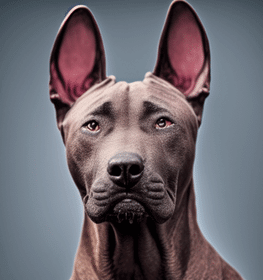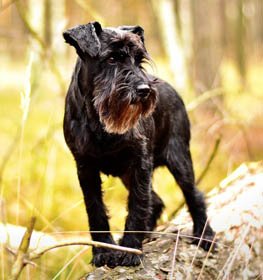Thai Ridgeback Information & Dog Breed Facts
Collection of all the general dog breed info about Thai Ridgeback so you can get to know the breed more.
| Group | Hunting Dogs |
|---|---|
| Popularity Rank | 296 |
| Reviews | 3 |
| User Ratings | |
|
Compare the Thai Ridgeback With Other Dogs
Select at least one dog breed to make the comparsion. | |
 | |
| Origin | |
|
Common Names & Aliases
What other names is a Thai Ridgeback known by? Discover all traditional, regional and informal names used for this breed. | Mah Thai Lung ArnThai DogMah Thai |
|---|---|
|
Breed Classification
What type of dog breed is a Thai Ridgeback? Learn about its genetic classification and breeding category. | Purebred |
Photo Gallery of the Thai Ridgeback Breed
|
Size Classification
What size category is a Thai Ridgeback? Learn how big the Thai Ridgeback breed typically grows. | Medium |
|---|---|
|
Weight Statistics
How much does a Thai Ridgeback weigh? Discover typical weight ranges for adult males and females of the Thai Ridgeback breed. | 51-75 pounds (23-34 kg) |
|
Average Weight
What is the average weight of a Thai Ridgeback? | 63 pounds (28.5 kg) |
|
Height
How tall is the Thai Ridgeback? Thai Ridgeback height: | Male: 22-24 inches (56-60 cm), Female: 20-22 inches (51-56 cm) |
|
Average Height
What is the average height of a Thai Ridgeback? | Male: 23 inches (58 cm), Female: 21 inches (53.5 cm) |
|
Price Range
How much does a Thai Ridgeback puppy cost? Find current market prices and factors affecting Thai Ridgeback costs. | $600-$800 If you choose to purchase the Thai Ridgeback, you should know that the mentioned amount of money is an average of the collected data from breeders’ sites and puppy finder places. If you have a Thai Ridgeback for sale, please advertise it on a reliable website to make sure the Thai Ridgeback gets to a happy place. |
|---|---|
|
Availability
How easy is it to get a Thai Ridgeback? How many Thai Ridgeback are there in the world? | Average: The Thai Ridgeback is a commonly available dog breed. There is less risk of overbreeding compared to the very popular dogs. Of course, they may be more popular in some countries, and inbreeding may occur, so be careful. |
|
Intelligence Rating
How intelligent is a Thai Ridgeback? Discover the Thai Ridgeback's intelligence ranking and learning capabilities. | Average: It takes patience to teach this breed any tricks or commands, but the effort is worth it. They understand and remember new commands after an average of 25-40 repetitions.
The Thai Ridgeback ranks average in the intelligence ranking of dogs. |
|---|---|
|
Training Difficulty
How easy is it to train a Thai Ridgeback? Learn about the Thai Ridgeback's trainability and response to training methods. | A slightly harder to train than average. Thai Ridgeback dogs aren't famous for their trainability. This breed needs more time and repetition to obey. It's challenging to teach them new commands, but not impossible. |
|
Watchdog Rating
How good is a Thai Ridgeback as a watchdog? Learn about the Thai Ridgeback's alertness and guarding instincts. | Thai Ridgeback dogs are not the best watchdogs. They aren't very territorial and protective about their property, so they probably won't alert you if they sense something different. |
|
Territorial Protection
Is a Thai Ridgeback protective of its territory? Learn about the Thai Ridgeback's guarding instincts and behavior. | Thai Ridgeback dogs can't provide protection for their territory. It's better to leave them out of the duty of protecting your valuables and property. |
|
Personality Traits
What personality does a Thai Ridgeback have? Learn about characteristic Thai Ridgeback temperament and behavior traits. | LovingIndependentProtectiveIntelligentLoyalFamiliar |
|---|---|
|
Sensitivity Level
How sensitive are they? Thai Ridgeback sensitivity: | Sensitive: Thai Ridgeback dogs don't like an irregular daily routine, noisy household, and frequent guest visits.
This breed's emotional level reflects their owner's feelings and they don't handle punishments well. |
|
Affection Level
How affectionate are they? Is a Thai Ridgeback a good family dog? | Slightly Below Average: Thai Ridgeback dogs may seem unfriendly sometimes due to their independence. Their happiness doesn't depend on their owner's emotional level. |
|
Social Needs
How much social interaction does the Mah Thai Lung Arn need? Thai Ridgeback social needs: | Thai Ridgeback dogs need for social interaction is average. This breed likes being around people or other animals, but they don't mind being left alone for a few hours either. |
|
Impulse to Wander or Roam
How likely is the Thai Ridgeback to run away? Does this breed explore or wander a lot? Does Thai Ridgeback roam? | Thai Ridgeback dogs have average wanderlust potential. Sometimes they like to explore the world and they might escape once or twice, but usually, they prefer staying safely at home. Safer to teach them how to get back to you on command. |
|
Prey Drive
Do this canine have a strong prey drive? Does Thai Ridgeback have high prey drive? | Thai Ridgeback dogs have a high impulse to chase and catch something. Cats or any other small animals are in danger. It's a natural instinct, doesn't necessarily mean that Thai Ridgeback dogs are aggressive. Better to keep this breed on a leash. |
|
Barking Frequency
Does a Thai Ridgeback bark a lot? Learn about typical Thai Ridgeback vocalization patterns and triggers. | Low to Average: The Thai Ridgeback rarely barks. This breed could be a good choice if you're looking for a quiet breed. They don't bark unless there is a good reason.
Top reasons for barking: protection, alarm, fear, boredom, attention-seeking, greeting, separation anxiety, compulsive barking. |
|---|---|
|
Playful Nature
How playful is a Thai Ridgeback? Understand the typical play drive and energy level of the Thai Ridgeback breed. | Average: Thai Ridgebacks, like any other dog breed, like playing. Sometimes they bark in excitement for playing, but they are not the most playful dog breed. |
|
Apartment Adaptability
Can a Thai Ridgeback live in an apartment? Learn about the Thai Ridgeback's suitability for apartment living. | It is not the best choice if you want to keep them indoors, however, with careful exercise and several walks a day, they will tolerate the indoor environment, so it is possible to keep Thai Ridgeback indoors. |
|
Lifestyle Adaptability
How adaptable is a Thai Ridgeback to lifestyle changes? Learn about the Thai Ridgeback's flexibility to new situations. | Thai Ridgeback dogs adapt very well to lifestyle changes and basically all living environments. They don't mind moving from one place to another with their owner. |
|---|---|
|
Alone Time Tolerance
Can a Thai Ridgeback be left alone? Learn about the Thai Ridgeback's tolerance to solitude. | Just like every puppy, they are prone to panic, cry, bark, whine when they left alone by their owner. With proper socialization and quality time with the dog can solve this problem. |
|
Bite Risk Assessment
What is a Thai Ridgeback biting potential? Learn about the Thai Ridgeback's bite risk factors. | Low 🔽 The Thai Ridgeback has a low chance of biting somebody. Top reasons for dog bite: protection, pain, excitement, herding instinct, being provoked. (Data based on the available online bite statistics.) |
|---|---|
|
Mouthing Tendency
Is a Thai Ridgeback mouthy? Learn about the Thai Ridgeback's tendency to use mouth during play. | Thai Ridgeback dogs have a higher than average tendency to nip, chew, playbite, or herd people. It's a common habit during puppyhood, not aggressive behavior. These "bites" don't hurt, but Thai Ridgeback dogs need to be taught a good attitude. |
|
Bite Strength Rating
How strong is a Thai Ridgeback bite? Learn about the Thai Ridgeback's bite force measured in PSI. | Between 200 and 400 PSI ⏺ Thai Ridgeback bite force: Ordinary. Bite force Thai Ridgeback measurements typically fall within the range of 200 to 400 PSI. The bite force of a Thai Ridgeback is considered ordinary when compared to other dog breeds, but it is still quite powerful. This Thai Ridgeback bite force PSI can cause bite wounds. Thai Ridgeback bite PSI is not something that should be feared if the dog is well-trained and managed. To avoid any issues, it's essential to learn how to train a Thai Ridgeback puppy not to bite from an early age.
The Thai Ridgeback, and many others, have a fearsome presence because they have significant jaw strength, so it is important not to anger the dog and have it around strangers until it is fully trained. However, they are usually quite calm and good companions, they work well in families and are easy to care for. In conclusion, while the Thai Ridgeback bite force is certainly an interesting aspect of the breed, it is important not to let it overshadow the many other reasons why these dogs are so loved and respected. With proper training and socialization, a Thai Ridgeback can be a loyal and protective companion for your family. |
|
Average Lifespan
How long does a Thai Ridgeback live? Learn about the typical lifespan of the Thai Ridgeback breed. | 11-13 years The average lifespan of Thai Ridgeback: 12 years |
|---|---|
|
Climate Tolerance
How well does a Thai Ridgeback handle different weather? Learn about the Thai Ridgeback's climate adaptability. | Prefers average to warm weather conditions Different dogs have different preferences when it comes to weather conditions. However, in general, most dogs prefer average to warm weather conditions, as they typically find hot weather conditions to be uncomfortable and taxing. |
|
Health Concerns
What health issues are common in a Thai Ridgeback? Discover typical conditions affecting the Thai Ridgeback breed. | Thai Ridgebacks tend to have more frequent health issues than other breeds. Regular vet check-ups are needed.
|
|
Vet Care Frequency
How often does a Thai Ridgeback need vet visits? Learn about the Thai Ridgeback's veterinary care requirements. | Frequent The Thai Ridgeback should have a complete physical check-up at least once (but preferably twice) per year. If your dog shows any symptoms, call your veterinarian. |
|
Energy Rating
How energetic is a Thai Ridgeback? Understand daily activity needs of the Thai Ridgeback breed. | Thai Ridgeback dogs have a higher energy level than other dog breeds. If you want a dog for snuggling on the couch, this breed isn't the perfect choice for you. |
|---|---|
|
Activity Requirement / Exercise Need
How much exercise does a Thai Ridgeback need? How much exercise do Thai Ridgeback dogs require per day?
Do Thai Ridgeback dogs need a lot of exercises? | Thai Ridgeback dogs need quite a lot of exercise. Daily walks should be on schedule. If you live an active life, this breed can be a good choice for you. |
|
Sleeping Need
How much sleep does the Thai Ridgeback breed need? | Thai Ridgeback dogs are quite energetic dogs and they don't spend too much time with sleeping. If you live an active life, this breed can be a good choice for you. |
|
Obesity Tendency
Is a Thai Ridgeback prone to weight gain? Learn about the Thai Ridgeback's obesity risks. | Average: The Thai Ridgeback has an average risk for obesity. Daily walks should be on schedule. To make your dog happy and fit, feed him with quality dry dog food and live an active life together. Try to find the happy medium between exercise and feeding.
If you notice any weight gain, consult your veterinarian and make a diet plan. Reduce unhealthy food and snacks, and measure the Thai Ridgeback weight regularly. |
|---|---|
|
Food Consumption
How much food does a Thai Ridgeback need daily? Learn about the Thai Ridgeback's feeding requirements. | 2.5 to 3.5 cups of a high-quality dog food daily, divided into two meals. |
|
Allergy Friendliness
Is a Thai Ridgeback hypoallergenic? Learn about the Thai Ridgeback's suitability for allergy sufferers. | No Thai Ridgeback dogs don't do well with allergy sufferers by causing allergic reactions. Some dog breeds are even considered to higher possibility of an allergic response. Coat type isn't necessarily relevant, because most people are allergic to dander (flakes on the dog's skin) or saliva, not actually to dog hair. |
|---|---|
|
Coat Colors
What colors does a Thai Ridgeback come in? Discover all possible Thai Ridgeback color variations. | Black Red Blue White Brown Brindle |
|
Grooming Requirements
How much grooming does a Thai Ridgeback need? Learn about Thai Ridgeback coat maintenance requirements. | Effortless: The Thai Ridgeback requires minimal grooming. Seasonal flea treatment is needed, but cutting the dog's hair by a professional groomer isn't necessary. Ears and eyes should be cleaned sometimes to avoid infections. Thai Ridgeback is one of the best choices if you don't have the time, skill, or money to take care of a high-maintenance dog. Highly recommended for beginners. |
|
Drooling Tendency
Does a Thai Ridgeback drool a lot? Learn about the Thai Ridgeback's drooling habits. | The Thai Ridgeback is a perfect example of a low drooling tendency. If you dislike being covered by slobber spots on your clothes, the Thai Ridgeback could be a good choice for you. Drooling is the unintentional saliva flowing outside of the mouth. It can be completely normal or a sign of a health problem. Certain dog breeds drool less than others, just like the Thai Ridgeback.
If you notice any change in your dog's drooling habit, you should contact a vet as soon as possible. |
|
Stinkiness Rating
Does a Thai Ridgeback smell bad? Learn about the Thai Ridgeback's natural odor levels. | Medium ⏺ The Thai Ridgeback has an average chance of bad smell. Top reasons for dog stinkiness: infection of bad tooth/ear/skin folds, gas attacks. |
|
Coat Characteristics
What type of coat does a Thai Ridgeback have? Learn about the Thai Ridgeback's fur characteristics. | Smooth |
|
Bathing Needs
How often does a Thai Ridgeback need baths? Learn about the Thai Ridgeback's bathing requirements. | 4-6 weeks Average. Experts recommended at least every 4-6 weeks for this family pup. According to a study, 56% of pet parents don’t bathe their dogs as frequently as they should, and 60% use the sniff test when deciding when it’s bath time.
Bathing your dog is beneficial to them in more ways than just one. It’s also a good time to look for unusual scratches, bumps, fleas, and other irregularities. When their hair is wet and flat against their body, these details are more visible. |
|
Shedding Level
How much do Thai Ridgeback dogs shed? How to control, reduce and prevent the shedding of the Mah Thai Lung Arn? Do Thai Ridgeback dogs shed a lot? | Thai Ridgeback dogs shed moderately. It's a natural process of the hair growth cycle. Regular brushing reduces the amount of hair that sheds. It mostly depends on their health status and breed type. |
|
Child Compatibility
Is a Thai Ridgeback good with children? Learn about the Thai Ridgeback's behavior around kids of different ages. | Thai Ridgeback dogs are kid-friendly dogs. This breed is a good choice if you have children. |
|---|---|
|
Pet Compatibility
How well does a Thai Ridgeback get along with other pets? Discover the Thai Ridgeback's compatibility with other animals. | Thai Ridgeback dogs do best when they’re the only pet at the family. |
|
Stranger Friendly
Are they aggressive or friendly towards/with strangers? Thai Ridgeback temperament with other people: | Thai Ridgeback dogs are not stranger friendly dogs. |
|
Cat Friendly
How well do Thai Ridgeback dogs get along with cats? Are they good with kittens? What is this fido's temperament with cats? Can they be good with cats? Can the Thai Ridgeback breed live with a cat? | Thai Ridgeback dogs are not cat-friendly dogs. |
|
Dog Friendly
Is Thai Ridgeback good with other dogs? Are they dog-friendly dogs? How well do Thai Ridgeback dogs get along with other dogs? | Thai Ridgeback dogs are not the most dog-friendly dogs. If you want more dogs in your family or you'd like to join dog meetups, the Thai Ridgeback is not a good choice. |
|
Good For First Time Owners
Is Thai Ridgeback breed good for first-time owners? Do they make a good dog for novice owners? Is Thai Ridgeback breed suitable for first-time owners? | No Thai Ridgeback dogs are not good for novice owners, due to their stubborn personality. |
|
Office Friendly
Are Thai Ridgeback dogs good office canines? Do Thai Ridgeback dogs make good office-friendly pets? Can they be office dogs? | No Thai Ridgeback is not the best dog breed for office environment. |
|
Senior Citizens Friendly
Are they senior citizens friendly dogs? How well do Thai Ridgeback dogs get along with the elderly people? What is the Mah Thai Lung Arn temperament with senior people? Are Thai Ridgeback dogs good for elderly owners? | Thai Ridgebacks are usually recommended for elderly people. |
|
Service Dog Capability
Can a Thai Ridgeback be a service dog? Learn about the Thai Ridgeback's service work potential. | Not really This breed generally not used as a service dog. A service dog is a term used in the USA to refer to any type of assistance dog specifically trained to help people who have disabilities, such as visual impairment, hearing impairments, mental disorders, seizures, mobility impairment, and diabetes. Service dogs are protected under the ADA (Americans with Disabilities Act).
Thai Ridgeback is not the best breed for service purposes. |
|---|---|
|
Therapy Work Suitability
Is a Thai Ridgeback good as a therapy dog? Learn about the Thai Ridgeback's therapy work aptitude. | Not really This breed is generally not used as a therapy dog. A therapy dog is a dog that might be trained to provide affection, comfort, and love to people in hospitals, retirement homes, nursing homes, schools, hospices, disaster areas, and people with anxiety disorders or autism.
Thai Ridgeback is not the best breed for therapeutic purposes. |
|
Scent Detection Ability
Is a Thai Ridgeback good at detection work? Learn about the Thai Ridgeback's scenting abilities. | Not really They are not typically employed for this type of work, but there may be exceptional cases. A detection dog or sniffer dog is a dog that is trained to use its senses (mostly its smell) to detect substances such as explosives, illegal drugs, wildlife scat, currency, blood, and contraband electronics such as illicit mobile phones.
Thai Ridgeback is not the best breed for detection purposes. |
|
Search & Rescue Potential
Can a Thai Ridgeback do search and rescue? Learn about the Thai Ridgeback's SAR capabilities. | Not really This dog breed is not typically used as a search and rescue dog. The use of dogs in search and rescue (SAR) is a valuable component in wilderness tracking, natural disasters, mass casualty events, and locating missing people.
The Thai Ridgeback is not the best breed for SAR purposes. |
|
Maritime Work Ability
Is a Thai Ridgeback good on boats? Learn about the Thai Ridgeback's maritime capabilities. | Not really Thai Ridgeback breed usually doesn't like being on a boat. Boat dogs were typically bred for their strength, stamina, and water resistance, as they were often required to perform tasks such as pulling in fishing nets, and jumping into the water to retrieve ropes or lines, or helping to move cargo. Sailor dog is a type of dog that was bred to accompany sailors on their voyages. They were typically used for three purposes: as a working dog, a watchdog, and as a companion. A boat dog is a term used to describe a type of dog that was traditionally bred and used as a working dog on boats. |
|
Draft Work Capability
Can a Thai Ridgeback pull carts? Learn about the Thai Ridgeback's drafting abilities. | Not really A drafting dog or draft dog is a dog bred and used for cart pulling. Dogs bred for this work have strong builds and qualities that are needed, strength and determination.
Thai Ridgeback is not the best breed for drafting purposes. |
|
Military Service Background
Was a Thai Ridgeback used in military service? Learn about the Thai Ridgeback's military history. | Not really In history, this breed was not really used for combat dog. |
|
Puppy Litter Size
How many puppies does a Thai Ridgeback usually have? Learn about typical litter sizes. | 4-5 puppies |
|---|---|
|
Pregnancy Duration
How long is a Thai Ridgeback pregnant? Learn about the Thai Ridgeback's gestation period. | 60-64 days Reproductive cycle of the female Thai Ridgeback: The first period called Proestrus lasts for about 9 days.
During this time the females start to attract males. You can notice by swelling vulva and bloody discharge. The second part is the Estrus when the female is receptive for the male. It lasts for about 3 to 11 days. The sign of the proestrus part is the soft and enlarged vulva. The discharge decreases and lightens in color. The third part is the Diestrus. Normally, it occurs around day 14. In this period the female’s discharge changes for vivid red and coming to its end. The vulva returns to average, and she will no longer permit mating. The fourth part called the Anestrus. The time frame between heat periods normally lasts about six months. |
|
Breeding Frequency
How often can a Thai Ridgeback have puppies? Learn about safe breeding intervals. | Once a year. More frequent breeding is not healthy. It is very important not to buy a dog from a puppy mill, where the needs of the pups and their mothers are ignored. It's an inhumane high-volume dog breeding facility, where puppies born several times a year. |
|
AKC Classification
What AKC group is a Thai Ridgeback in? Learn about the Thai Ridgeback's AKC classification. | Not recognized by the American Kennel Club. |
|---|---|
|
FCI Classification
What FCI group is a Thai Ridgeback in? Learn about the Thai Ridgeback's international classification. | Recognized by FCI in the Spitz and primitive types group, in the Primitive type - Hunting Dogs section. |
|
Kennel Club Recognition
Which kennel clubs recognize a Thai Ridgeback? Learn about the Thai Ridgeback's official recognition. | American Canine RegistryAmerica's Pet RegistryDog Registry of America Inc.Federation Cynologique InternationaleNorth American Purebred Registry, Inc.American Canine Association, Inc.National Kennel ClubFoundation Stock Service |
Thai Ridgeback Pros and Cons
- Grooming Requirements: Effortless: The Thai Ridgeback requires minimal grooming.
- Drooling Tendency: The Thai Ridgeback is a perfect example of a low drooling tendency.
- Lifestyle Adaptability: Thai Ridgeback dogs adapt very well to lifestyle changes and basically all living environments.
- Child Compatibility: Thai Ridgeback dogs are kid-friendly dogs.
- Senior Citizens Friendly: Thai Ridgebacks are usually recommended for elderly people.
- Training Difficulty: A slightly harder to train than average.
- Health Concerns: Thai Ridgebacks tend to have more frequent health issues than other breeds.
- Allergy Friendliness: Thai Ridgeback dogs don't do well with allergy sufferers by causing allergic reactions.
- Watchdog Rating: Thai Ridgeback dogs are not the best watchdogs.
- Mouthing Tendency: Thai Ridgeback dogs have a higher than average tendency to nip, chew, playbite, or herd people.
- Cat Friendly: Thai Ridgeback dogs are not cat-friendly dogs.
- Dog Friendly: Thai Ridgeback dogs are not the most dog-friendly dogs.
- Office Friendly: Thai Ridgeback is not the best dog breed for office environment.
- Good For First Time Owners: Thai Ridgeback dogs are not good for novice owners, due to their stubborn personality.
Thai Ridgeback History
The Thai Ridgeback is a very ancient breed dating back to 4000 years according to archaeological drawings. It is believed that the breed originates from the isolated Islands of Western Thailand. Moreover, the Thai Ridgeback is considered to be a “pariah-type” dog, a term used to describe part-wild, free-range dogs that live on the outskirts of human civilization and reproduce almost entirely by natural selection. Pariah dogs, just like the Thai Ridgeback, have remained much the same over time because there were fewer opportunities for them to breed with different types of dogs. However, it is not 100% clear whether the Thai Ridgeback actually evolved from Asian pariah dogs, but some evidence found from the 17th century suggests that. The earliest written documentation seems to come from an ancient manuscript of the period of King Sonthan of Ayutthaya (1611-1628) who described the breed as follows; “The dogs are big, they appear in a variety of colors. They are fierce. They are loyal to their masters.” “When they catch an animal they will bring it to their masters.” This also shows that the Thai Ridgebacks were originally used for hunting. They hunted wild boar, deer, tapirs, and birds. They were also used to escort carts alongside their masters, which were the mode of transport in Thailand at that time.
Furthermore, it has only been with the introduction of modern-day transport that these dogs have begun to get more widely publicized and recognized around Thailand and the western world. However, intense deforestation throughout Thailand has destroyed most hunting habitats and the Thai Ridgebacks were no longer used in the same way. Nowadays they seem to be used mainly for guarding their master’s family and property. It is considered a real status symbol to own a Thai Ridgeback in Thailand. Especially the government, military, and police officials seem to be keen enthusiasts of this breed.
Moreover, the Dog Association of Thailand was founded in 1976 and recognized the indigenous Thai Ridgeback as an official breed. There have been many speculations regarding their numbers in Thailand, but not all of them are registered. In 2002 the actual recorded number was only 367 in the Kennel Club of Thailand. The first one to be exported out of Thailand was in 1990 by ray Mersmann from Hilland with his blue male called Hintza. A few years later, they were also brought to the United States, in 1994, by a rare dog breed enthusiast Jack Sterling. The breed has been a member of the AKC’s Foundational Stock service since 1997 and has been designated part of the Hound group.
Latest Thai Ridgeback Compares
Thai Ridgeback Names
How old is my Thai Ridgeback in human years?
You May Also Like
Rate The Thai Ridgeback Breed
Thai Ridgeback Comments, Reviews and Questions
- John King
Oct 5, 2021, 1:00:15 AM:
The review above is largely incorrect. The Thai ridgeback is an incredibly good guard dog and quite fierce. Also, this dog has virtually no health issues at all. This dog is a land shark! But lovable and loyal to the family for sure.
- Michael Hickman
Oct 3, 2021, 8:15:06 AM:
I disagree that these are not kid friendly dogs. However, they are very stubborn and quite demanding until fully trained, so not recommended for novice owners Otherwise, very friendly, loyal and affectionate
- TRD first of few
Dec 9, 2019, 10:09:53 AM:
These are not kid friendly dogs.














